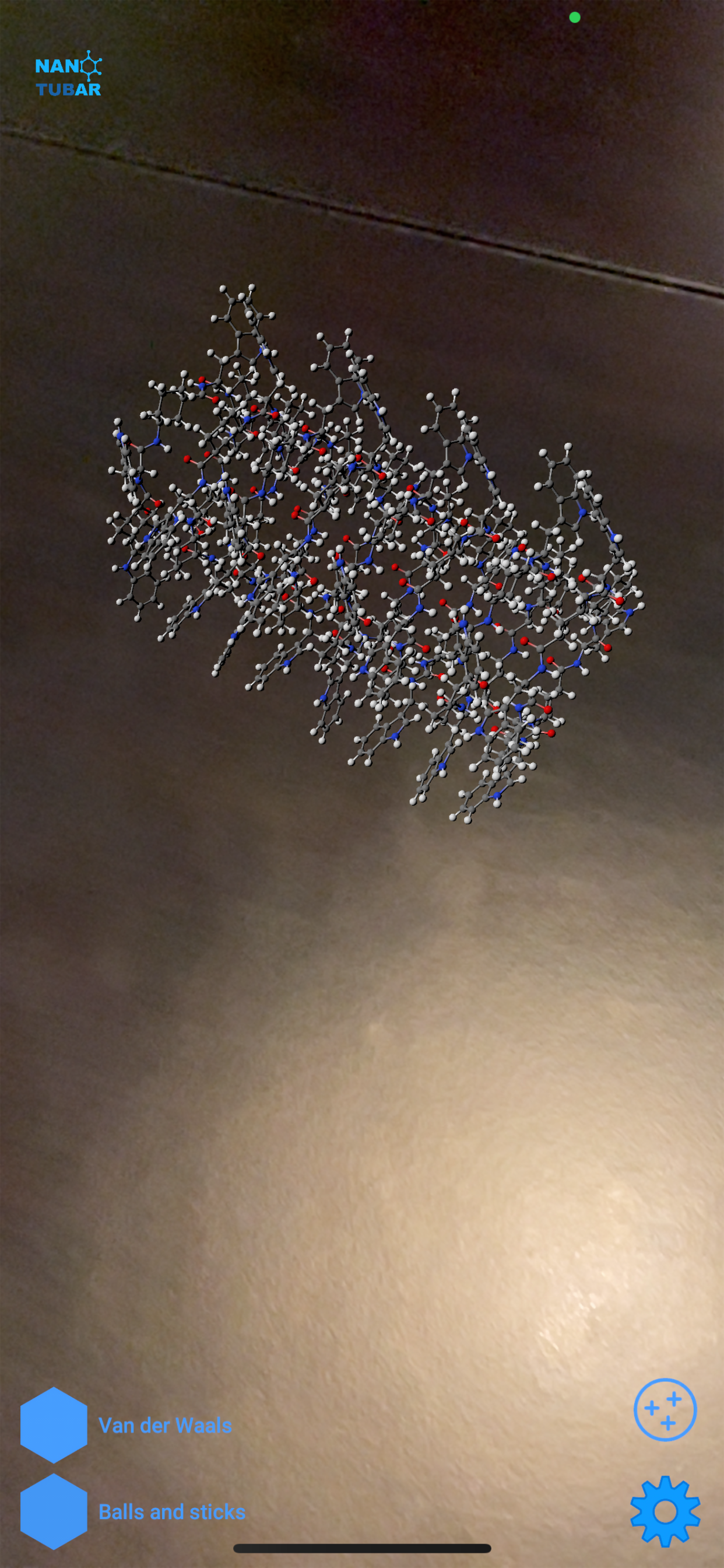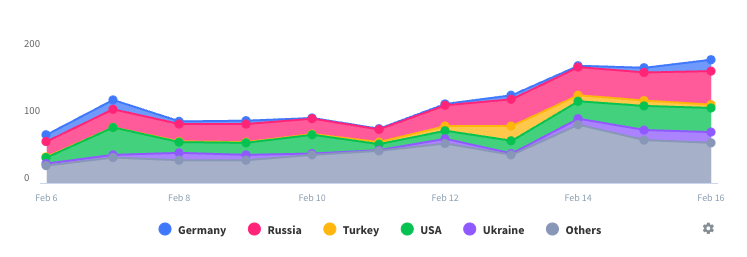
NanoTubAR
Published by: MD. USE INNOVATIONS SL
Description
"Nanoscience" is the branch of science that is responsible for the study of objects at the nanometric scale, that is, those whose sizes are between 1 and 100 nm. One of the great challenges of nanotechnology is the preparation of new functional materials whose dimensions and structures are controlled at the molecular or atomic level. In chemistry, nanotubes are tubular (cylindrical) structures, with typical diameter sizes in the scale of a nanometer. There are nanotubes of many materials. Among the best-known are carbon nanotubes (CNT) made up of rolled sheets of carbon atoms, with physical and chemical properties that open the door to an immense horizon of applications. In addition to CNTs, there are nanotubes formed by the self-assembly of cyclic peptides. This type of nanostructures has attracted great attention from the scientific community in recent years due to their important applications in biology, chemistry and materials science. Much of this interest is related to its technological possibilities such as biosensors, photosensitive materials, antimicrobial agents, selective transport systems, molecular electronics and other potential uses in biology, electronics and optics.
The history of these nanotubes began in 1974, when De Santis predicted the formation of tubular structures by cyclic peptides, formed by alpha amino acids with alternating stereochemistry, D and L (D, L-α-CPs). However, it was not until 1993 when they were prepared in a laboratory thanks to Professor Ghadiri's group at Scripps. Their applications comprehend those that involve interaction with membranes, including the use as antimicrobials or as biomimetics of natural channels. Their hydrophilic internal cavity facilitates the transport of water and hydrophilic molecules of appropriate size, such as ions or drugs. The external properties of the nanotube are defined by the side chains of the amino acids that make up the cyclic peptide, oriented towards the outside. More recently, in the group of Prof. Juan R. Granja, at the University of Santiago de Compostela, nanotubes formed by cyclic peptides that alternate alpha amino acids with other types of artificial amino acids, such as gamma (α, γ-CPs) or delta (α, δ-CPs) have been designed and synthesized. This type of non-natural amino acids allows methylene groups to be introduced into the cavity of the channels, increasing their hydrophobicity and allowing their internal functionalization.
NanotubAR allows to visualize, using Augmented Reality technology, four types of nanotubes: a carbon nanotube (CNT) and three nanotubes formed by cyclic peptides. The representation of the nanotubes included in the app are not just cartoons, they come from realistic atomistic models resulting from computational simulations. In each of them, natural alpha amino acids (L-tryptophan) are combined with synthetic residues, such as D-tryptophan (D, L-alpha-CPs), gamma amino acids (alpha, gamma-CPs) and delta amino acids (alpha, delta -CPs). In all these designs, the amino and carbonyl groups of the amino acids are oriented perpendicularly to the plane of the cyclic peptides, with a suitable orientation to establish hydrogen bonds between the different units, and thus forming a tubular structure.
With NanotubAR it is possible to obtain a privileged view of these systems in our own home, or anywhere, from a simple texture, walk around it, and even enter its inner cavity to be able to observe its interior structure in detail at a level atomistic detail. In addition, NanotubAR allows changing the representation of the atoms that make up the systems and choosing between “ball and stick” or a van der Waals representation. Delve into nanotechnology and share with your friends a photo inside your favorite nanotube!
Hide
Show More...
The history of these nanotubes began in 1974, when De Santis predicted the formation of tubular structures by cyclic peptides, formed by alpha amino acids with alternating stereochemistry, D and L (D, L-α-CPs). However, it was not until 1993 when they were prepared in a laboratory thanks to Professor Ghadiri's group at Scripps. Their applications comprehend those that involve interaction with membranes, including the use as antimicrobials or as biomimetics of natural channels. Their hydrophilic internal cavity facilitates the transport of water and hydrophilic molecules of appropriate size, such as ions or drugs. The external properties of the nanotube are defined by the side chains of the amino acids that make up the cyclic peptide, oriented towards the outside. More recently, in the group of Prof. Juan R. Granja, at the University of Santiago de Compostela, nanotubes formed by cyclic peptides that alternate alpha amino acids with other types of artificial amino acids, such as gamma (α, γ-CPs) or delta (α, δ-CPs) have been designed and synthesized. This type of non-natural amino acids allows methylene groups to be introduced into the cavity of the channels, increasing their hydrophobicity and allowing their internal functionalization.
NanotubAR allows to visualize, using Augmented Reality technology, four types of nanotubes: a carbon nanotube (CNT) and three nanotubes formed by cyclic peptides. The representation of the nanotubes included in the app are not just cartoons, they come from realistic atomistic models resulting from computational simulations. In each of them, natural alpha amino acids (L-tryptophan) are combined with synthetic residues, such as D-tryptophan (D, L-alpha-CPs), gamma amino acids (alpha, gamma-CPs) and delta amino acids (alpha, delta -CPs). In all these designs, the amino and carbonyl groups of the amino acids are oriented perpendicularly to the plane of the cyclic peptides, with a suitable orientation to establish hydrogen bonds between the different units, and thus forming a tubular structure.
With NanotubAR it is possible to obtain a privileged view of these systems in our own home, or anywhere, from a simple texture, walk around it, and even enter its inner cavity to be able to observe its interior structure in detail at a level atomistic detail. In addition, NanotubAR allows changing the representation of the atoms that make up the systems and choosing between “ball and stick” or a van der Waals representation. Delve into nanotechnology and share with your friends a photo inside your favorite nanotube!
Screenshots
NanoTubAR FAQ
-
Is NanoTubAR free?
Yes, NanoTubAR is completely free and it doesn't have any in-app purchases or subscriptions.
-
Is NanoTubAR legit?
Not enough reviews to make a reliable assessment. The app needs more user feedback.
Thanks for the vote -
How much does NanoTubAR cost?
NanoTubAR is free.
-
What is NanoTubAR revenue?
To get estimated revenue of NanoTubAR app and other AppStore insights you can sign up to AppTail Mobile Analytics Platform.

User Rating
App is not rated in Netherlands yet.

Ratings History
NanoTubAR Reviews
Store Rankings

Ranking History
App Ranking History not available yet

Category Rankings
App is not ranked yet
NanoTubAR Competitors
| Name | Downloads (30d) | Monthly Revenue | Reviews | Ratings | Recent release | |
|---|---|---|---|---|---|---|
|
Visualizing Organic Chemistry
Make Organic Chemistry Dynamic
|
Unlock
|
Unlock
|
0
|
|
1 year ago | |
|
Turning Genes into Medicine
|
Unlock
|
Unlock
|
0
|
|
1 year ago | |
|
Experimental Organic Chemistry
N/A
|
Unlock
|
Unlock
|
0
|
|
2 years ago | |
|
1HCSC
|
Unlock
|
Unlock
|
0
|
|
10 months ago | |
|
Steiner Tree
|
Unlock
|
Unlock
|
0
|
|
2 years ago | |
|
Strings Conferences
|
Unlock
|
Unlock
|
0
|
|
5 months ago | |
|
PocketMDS
|
Unlock
|
Unlock
|
0
|
|
2 years ago | |
|
CrystalAspect
|
Unlock
|
Unlock
|
0
|
|
1 year ago | |
|
MacromoleculAR
View molecules in AR
|
Unlock
|
Unlock
|
0
|
|
1 year ago | |
|
N/A
quantum circuit for everyone!
|
Unlock
|
Unlock
|
0
|
|
1 year ago |
NanoTubAR Installs
Last 30 daysNanoTubAR Revenue
Last 30 daysNanoTubAR Revenue and Downloads
Gain valuable insights into NanoTubAR performance with our analytics.
Sign up now to access downloads, revenue, and more.
Sign up now to access downloads, revenue, and more.
App Info
- Category
- Education
- Publisher
- MD. USE INNOVATIONS SL
- Languages
- English
- Recent release
- 1.0 (3 years ago )
- Released on
- Feb 4, 2021 (3 years ago )
- Also available in
- Spain, Portugal, Japan, South Korea, Kazakhstan, Lebanon, Nigeria, Netherlands, Norway, Peru, Philippines, India, Romania, Saudi Arabia, Sweden, Singapore, Türkiye, Taiwan, United States, Vietnam, South Africa, Germany, Austria, Azerbaijan, Brazil, Canada, Switzerland, Chile, China, Colombia, Czechia, Italy, Algeria, Ecuador, Egypt, United Kingdom, Greece, Hong Kong SAR China, Indonesia, Israel, Argentina
- Last Updated
- 1 month ago






